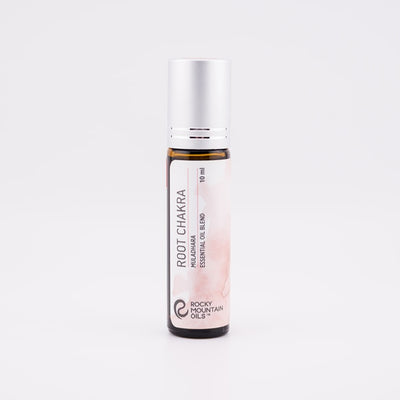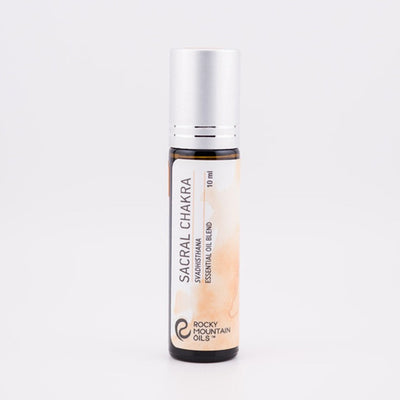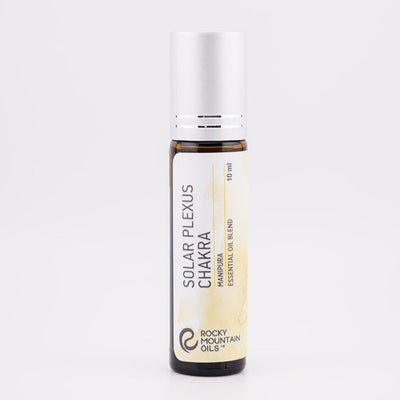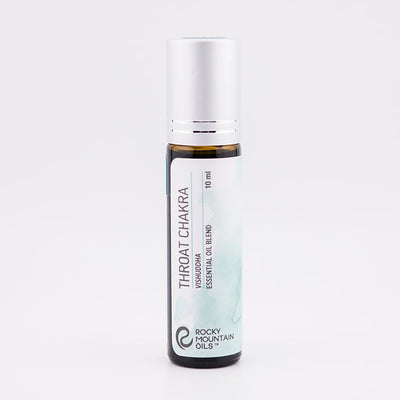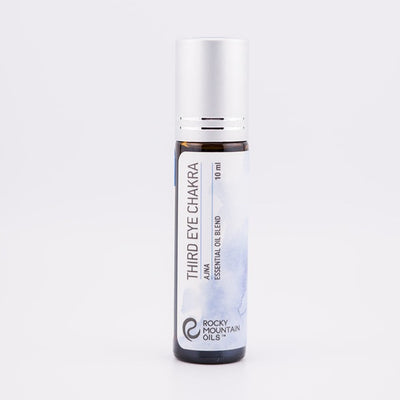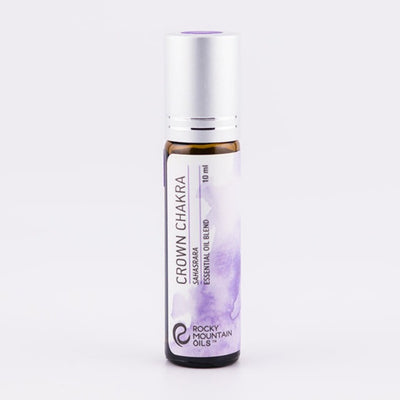Essential Oils for Chakras - A Beginner's Guide
Are you experiencing a lack of passion, security, or growth in your life?
If so, you may need to balance your chakras to restore your physical, mental, and spiritual harmony. Try essential oils for chakras to allow energy to flow more smoothly through your body and mind.
Save up to 30% OFF Chakra Diffuser Blends & Roll-ons NOW!
If you have ever attended a yoga class or meditation group, odds are you have at least heard of chakras. Your instructors may talk of how balanced chakras can improve your mind and body. But what exactly are chakras? How do they work? How do you know if they are unbalanced? And most importantly, what are the best essential oils for chakras?
What Are Chakras?
The word "chakra" is Sanskrit for "wheel" or "disc", and it refers to the energy centers within the human body. There are seven chakras that run from the base of the spine up to the crown of the head. Each chakra moves energy inside of you. When each chakra is balanced, you can experience harmony between your body, mind, and spirit.
The Seven Chakras
- Root Chakra (muladhara)
- Sacral Chakra (swadhisthana)
- Solar Plexus Chakra (manipura)
- Heart Chakra (anahata)
- Throat Chakra (vishuddha)
- Third Eye Chakra (ajna)
- Crown Chakra (sahasrara)

Because chakras are centers of moving energy, they can become blocked, or move too much or too little, becoming overactive or underactive. When you experience a blocked, overactive, or underactive chakra, your mental, spiritual, and physical health can suffer. If you experience any symptoms of an imbalanced chakra, there are ways that you can balance your chakras and restore harmony, including meditation, aromatherapy, affirmations, crystal healing, and eating chakra foods.
Root Chakra
The root chakra, or muladhara, is located at the base of the spine near the tailbone, and it extends up to just below the navel. It is identified with the color red and associated with the earth element. The root chakra is the foundation of your being and physical existence. It provides feelings of security and is the driving force behind decisions and actions that foster self-preservation and survival.
Characteristics of the Root Chakra
When your root chakra is balanced, you can experience a greater sense of accomplishment and peace, particularly when you think about things that influence your survival, such as money, shelter, and safety. A balanced root chakra helps you feel connected to the earth and your earthly human experience. It is the foundation upon which you can build upon during personal growth, providing feelings of security and safety. The root chakra is also very influential in your physical health and can support a healthy body when balanced.
Characteristics of an Overactive Root Chakra
When your root chakra is overactive, it is working too hard and can have a negative effect on your body. For example, some of the most common signs of an overactive root chakra include:
- Resentment or anger towards others
- Greediness
- Difficulty accepting change
- Impatience
- Fearfulness, or feeling a need to survive when there is no threat
- Digestive issues
- Lower back or hip pain
Characteristics of an Underactive Root Chakra
An underactive root chakra means that it is either blocked or not properly distributing energy. For example, key characteristics of an underactive root chakra include:
- Lack of feeling secure or sense of home
- Disorganized
- Lack of focus
- Feelings of nervousness, anxiousness, or fear of abandonment
- Disconnection from the earth
- Difficulty finding financial security
How to Balance The Root Chakra
It is important to keep your chakras balanced. When your root chakra is imbalanced, it can cause other chakras to become imbalanced as well. If you experience any symptoms of an imbalanced root chakra, try one or more of the following ways to balance your first chakra:
- Yoga for Root Chakra: Performing certain yoga poses can help re-establish feelings of being grounded and secure. Try the lotus pose, child's pose, triangle pose, and garland pose.
- Connect With The Earth and Others: Re-establish feelings of security by forming stronger and harmonious relationships with those around you, your environment, and Mother Earth. You can spend time outside in nature, or plant a garden.
- Meditation for Root Chakra: By meditating and focusing on your connection to spirit and earth, you can balance your root chakra.
- Aromatherapy for Root Chakra: Diffuse or apply essential oils that have an earthy aroma and grounding effects. Apply oils to your feet, legs, and base of the spine. Some essential oils for the root chakra include Vetiver, Frankincense, Patchouli, Pine, and our Root Chakra Blend.
- Root Chakra Affirmations: Affirmations can help reprogram negative thinking into positive thinking. Some root chakra affirmations include "I feel deeply rooted", "I love my body", "I am grounded", "My home is safe and secure", "My future is financially secure", and "I have" phrases.
- Root Chakra Crystals: The root chakra's complementary gemstone is bloodstone. Try meditating with the stone or carrying it with you to balance your root chakra.
- Root Chakra Foods: Eating red and root foods can help restore balance to your root chakra. These foods include raspberries, turnips, beetroot, potatoes, garlic, and onions.
Essential Oils for Root Chakra
Sacral Chakra
The sacral chakra, or swadhisthana, is located in the abdomen below the navel. It is identified with the color orange and associated with the water element. The sacral chakra is the center of your identity, and it is the home of creativity and passion. As a result, your sacral chakra motivates you to enjoy life and the fruits of your labor, as well as take joy in pleasurable activities, including intimacy.
Characteristics of the Sacral Chakra
When your sacral chakra is balanced, you can truly enjoy life and relish in pleasurable things without going overboard. The sacral chakra allows you to connect feelings and emotions, helps you develop intimate relationships, express your creativity, and explore what you are truly passionate about.
Characteristics of an Overactive Sacral Chakra
When your sacral chakra is overactive, it is working too hard and can cause you to feel physically and emotionally unstable. For instance, some of the most common signs of an overactive sacral chakra include:
- Overly emotional, moody, or dramatic
- Strong emotions of anxiety or aggression
- Increased emotional attachment to others
- Lack of personal boundaries
- Addictions or gluttony
- Restlessness
Characteristics of an Underactive Sacral Chakra
An underactive sacral chakra means that it is either blocked or not properly distributing energy. For instance, key characteristics of an underactive sacral chakra include:
- Lack of creativity
- Greater insecurity
- Emotionally closed off from others
- Frigidity or lack of desire
- Fear or shame of intimacy
- Sluggishness
How to Balance The Sacral Chakra
When your sacral chakra is imbalanced, it can disrupt your emotional and physical health. Therefore, if can be helpful to try one or more of the following ways to balance your second chakra:
- Yoga for Sacral Chakra: Performing hip-opening yoga poses can help balance your sacral chakra and restore your inner passion. Try the warrior 2 pose, goddess pose, and pigeon pose.
- Connect With Water: The sacral chakra is connected to the water element. You can help balance your sacral chakra by reconnecting with water. Take a warm bath or wade in a body of water.
- Practice Creativity: As the center of your creativity, your sacral chakra can become balanced when you participate in creative activities, such as drawing, dancing, or writing.
- Meditation for Sacral Chakra: By meditating and focusing on things that you enjoy in life, you can balance your sacral chakra.
- Aromatherapy for Sacral Chakra: Diffuse or apply essential oils that have cleansing and balance effects. Apply oils to your abdomen, just beneath the navel. Some essential oils for the sacral chakra include Orange, Rose, Ylang Ylang, and our Sacral Chakra Blend.
- Sacral Chakra Affirmations: Affirmations can help reprogram negative thinking into positive thinking. Some sacral chakra affirmations include "I am passionate", "I feel at peace", "I am open to experiencing the present moment", and "I feel" phrases.
- Sacral Chakra Crystals: The sacral chakra's complementary gemstone is carnelian. Try meditating with the stone or carrying it with you to balance your sacral chakra.
- Sacral Chakra Foods: Because the sacral chakra is identified by the color orange, eat orange foods to help balance your second chakra. These foods include carrots, sweet potatoes, and orange bell peppers.
Essential Oils for Sacral Chakra
Solar Plexus Chakra
The solar plexus chakra, or Manipura, is located in the center of the navel and extends up to the sternum. It is identified with the color yellow and associated with the fire element. The solar plexus chakra is the core of your personality and identity, radiating self-confidence and personal power. It harnesses the power within you to transform your thoughts into action, allowing you to create and live the life you want.
Characteristics of the Solar Plexus Chakra
When your solar plexus chakra is balanced, you have a strong sense of identity and feel true to yourself. The solar plexus chakra empowers you to control your thoughts, actions, and emotions, and it gives you the self-discipline to get things done. As the center of your personal confidence, a balanced solar plexus chakra will increase your self-esteem and overall confidence in yourself and your abilities.
Characteristics of an Overactive Solar Plexus Chakra
When your solar plexus chakra is overactive, it is working too hard and can bring a lack of control into your life. For example, some of the most common signs of an overactive solar plexus chakra include:
- A desire to be in control or micromanage others
- Feelings of anger or aggression
- Lack of compassion or empathy
- Digestive issues
- Perfectionism or being overly critical
Characteristics of an Underactive Solar Plexus Chakra
An underactive solar plexus chakra means that it is either blocked or not properly distributing energy. For example, key characteristics of an underactive solar plexus chakra include:
- Lack of confidence and low self-esteem
- Indecisiveness
- Greater timidness
- Seeking external approval and worrying about what others think
- Neediness
How to Balance The Solar Plexus Chakra
When your solar plexus chakra is imbalanced, it can disrupt your relationships with others and yourself. If you experience any symptoms of an imbalanced solar plexus chakra, try one or more of the techniques:
- Yoga for Solar Plexus Chakra: Performing certain yoga poses can help balance your solar plexus chakra and restore your sense of self-confidence. Try the boat pose, bow pose, lion pose, and seated spinal twist.
- Get Outside: The solar plexus chakra is connected to the fire element. Spending time outside in the sun can help restore balance to this chakra.
- Try New Things: Because the solar plexus chakra is the center of your identity, trying new things can help open your chakra and more fully identify who you are.
- Meditation for Solar Plexus Chakra: By meditating and focusing on what makes you who you are, you can balance your solar plexus chakra.
- Aromatherapy for Solar Plexus Chakra: Diffuse or apply essential oils that promote feelings of confidence, motivation, and courage. Additionally, you can apply oils to your abdomen a few inches above the navel. Some essential oils for the solar plexus chakra include Cedarwood, Lavender, Rosemary, and our Solar Plexus Chakra Blend.
- Solar Plexus Chakra Affirmations: Affirmations can help reprogram negative thinking into positive thinking. Some solar plexus chakra affirmations include "I feel my own powers," "I am authentic," "I am free to choose in all situations," and "I can" phrases.
- Solar Plexus Chakra Crystals: The solar plexus chakra's complementary gemstone is tiger's eye. Therefore, try meditating with the stone or carrying it with you to balance your solar plexus chakra.
- Solar Plexus Chakra Foods: Because the solar plexus chakra is identified by the color yellow, eat yellow, starchy, and easily digestible foods to help balance your solar plexus chakra. These foods include pineapple, squash, corn, bananas, and beans.
Essential Oils for Solar Plexus Chakra
- Cedarwood
- Lavender
- Rosemary
- Solar Plexus Chakra Roll-On Blend
- Solar Plexus Chakra 5ml Diffuser Blend
Heart Chakra
The heart chakra, or Anahata, is located in the center of the heart, and it extends up to the throat and down to the sternum. It is identified with the color green and associated with the air element. Additionally, the heart chakra originates your love, compassion, and trust. Your heart chakra is what makes you able to both give and receive love. It forms your deepest connections to others through compassion, affection, tenderness, and endearment. As a result, your heart chakra allows you to recognize that everyone is connected and build on those connections.
Characteristics of the Heart Chakra
When your heart chakra is balanced, you can form deep bonds with others in platonic and intimate relationships. It gives you the power to have compassion for others and understand what others are going through. As a result, you can express and share unconditional love. A balanced heart chakra allows you to let go of the past and forgive others. You can face hurt feelings and then move on to new experiences and relationships. In addition, the heart chakra allows you to love yourself and others openly.
Characteristics of an Overactive Heart Chakra
When your heart chakra is overactive, it is working too hard, which can cause you to exert yourself in your personal life and lead to toxic relationships. For example, some of the most common signs of an overactive heart chakra include:
- Lack of control over emotions
- Clingy or lack of personal boundaries
- Saying yes to everything, even if it hurts you
- Lack of sense of self in relationships
- Possessiveness
- Feelings of jealousy or superiority
Characteristics of an Underactive Heart Chakra
An underactive heart chakra is either blocked or not properly distributed energy. For example, key characteristics of an underactive heart chakra include:
- Isolation or distance in relationships
- Cold demeanor or lack of empathy toward others
- Unforgiving and grudgeful
- Overly critical of others and yourself
- Not willing to open up to others
How to Balance The Heart Chakra
When your heart chakra is imbalanced, it can disrupt your health and relationships. If you experience any symptoms of an imbalanced heart chakra, try one or more of the following ways to balance your fourth chakra:
- Yoga for Heart Chakra: Performing chest-opening yoga poses like the bow or camel pose can help balance your heart chakra.
- Get Fresh Air: The heart chakra is connected to the air element. Getting outside and away from the city and breathing in the fresh air can help balance your heart chakra.
- Volunteer or Serve Others: Because the heart chakra is the center of love and compassion, try doing things that will put you in someone else's shoes. Serving others or volunteering will help connect your compassion and empathy with others. You can also show yourself some love by taking some personal time.
- Meditation for Heart Chakra: By meditating and focusing on opening your heart, you can balance your heart chakra.
- Aromatherapy for Heart Chakra: Diffuse or apply essential oils that are uplifting and promote feelings of love, positivity, and joy. Apply oils to your chest area. Some essential oils for the heart chakra include Bergamot, Rose, Cypress, Jasmine, and our Heart Chakra Blend.
- Heart Chakra Affirmations: Affirmations can help reprogram negative thinking into positive thinking. Some heart chakra affirmations include "I am open to love," "I love and accept myself," "I live in a state of gratitude," and "I love" phrases.
- Heart Chakra Crystals: The heart chakra's complementary gemstone is rose quartz. Try meditating with the stone or carrying it with you to balance your heart chakra.
- Heart Chakra Foods: Because the heart chakra is identified by the color green, eat your greens and anything with chlorophyll. These foods include kale, celery, zucchini, broccoli, green grapes, kiwi, basil, and avocados.
The throat chakra, or vishuddha, is located directly between your collarbones, extending down to your heart and up to your eyes. It is identified with the color blue and associated with the ether element. The throat chakra is the center of motivation for authenticity and true originality. It is motivated by the expression of truth, allowing you to communicate your own thoughts and truths clearly.
Characteristics of the Throat Chakra
When your throat chakra is balanced, you can experience a personal power to be yourself and express yourself to others. When balanced, your throat chakra motivates and empowers you to speak your truth and stand up for what you believe in. As the center of your communication, your throat chakra also allows you to be creative and inspired and share your ideas with others.
Characteristics of an Overactive Throat Chakra
When your throat chakra is overactive, it is working too hard and can make it difficult for you to communicate with others. For example, some of the most common signs of an overactive throat chakra include:
- Inability to listen to others
- Overly critical
- Overly talkative and interruptive
- Feeling like you aren't heard by others
- Throat pain or discomfort
Characteristics of an Underactive Throat Chakra
On the other hand, an underactive throat chakra means that it is either blocked or not properly distributing energy. For example, key characteristics of an underactive throat chakra include:
- Shutting down as a result of not being heard
- Introverted, shy, or timid
- Difficulty speaking up
- Unable to express yourself or your needs
How to Balance The Throat Chakra
When your throat chakra is imbalanced, it can disrupt your ability to speak up. Try one or more of the following ways to balance your fifth chakra:
- Yoga for Throat Chakra: Performing yoga poses that stretch and open your throat can help balance your throat chakra and restore your inner voice. Try the lion pose, shoulder stand, plow pose, and fish pose.
- Get Outside: The throat chakra is connected to the ether element, which is the space around the other elements. Spending time outside on cloudless days can help restore proper energy flow in your throat chakra.
- Speak Up: Because the throat chakra is the center of your communication, try talking to others you feel comfortable with. You can also practice speaking aloud to yourself.
- Mediation for Throat Chakra: Try meditating and focusing on opening your throat.
- Aromatherapy for Throat Chakra: Diffuse or apply essential oils that encourage creativity and clarity. Some essential oils for the throat chakra include Peppermint, Basil, Cypress, and our Throat Chakra Blend.
- Affirmations: Affirmations can help reprogram negative thinking into positive thinking. Some throat chakra affirmations include "I am open and honest in my communication", "I have a right to speak my authentic truth", "I know when to listen", and "I speak" phrases.
- Throat Chakra Crystals: The throat chakra's complementary gemstone is lapis lazuli. Try meditating with the stone or carrying it with you to balance your throat chakra.
- Throat Chakra Foods: As the center of your communication and because of its association with the color blue, eating blue foods can help balance your throat chakra. Some blue foods include blueberries, blue algae, and kelp. You can also eat healing or soothing foods, particularly for your thyroid. These foods include coconut water, herbal teas, and raw honey.
The third eye chakra, or Ajna, is located directly between your eyebrows, radiating down to your mouth and up to the crown of your head. It is identified with the color indigo and is highly influenced by light. The third eye chakra is motivated by knowledge, intuition, and reflection. Additionally, it determines how you see both the outer world around you and your inner world. Your third eye chakra enables you to be more mindful, fully live in the present moment, and open your mind to deeper understanding.
Characteristics of the Third Eye Chakra
When your third eye chakra is balanced, you can open your mind to a deeper understanding and greater knowledge. Because your third eye chakra drives your perception of the world, a balanced third eye chakra can open you up to greater intuition and inner reflection. After all, when balanced, your third eye chakra opens up possibilities for self-reflection. Additionally, it is your link between your mind and the outer, physical world, and it helps you integrate the two.
Characteristics of an Overactive Third Eye Chakra
Therefore, when your third eye chakra is overactive, it is working too hard and can disrupt your relationship with the world around you. For example, some of the most common signs of an overactive third eye chakra include:
- Lacking good judgment
- Unable to focus
- Feeling mentally overwhelmed
- Analytical
- Mental fog
Characteristics of an Underactive Third Eye Chakra
However, an underactive third eye chakra means that it is either blocked or not properly distributing energy. For example, key characteristics of an underactive third eye chakra include:
- Rigid, inflexible thinking
- Not open to new ideas
- Fearful of the future
- Lack of intuition
- Inability to self-reflect
How to Balance The Third Eye Chakra
When your third eye chakra is imbalanced, it can cause emotional and physical stress. Try one or more of the following ways to balance your sixth chakra:
- Yoga for Third Eye Chakra: Performing certain yoga poses can help balance your third eye chakra and restore your inner understanding. Try the fish pose, shoulder stand, and child's pose.
- Get Outside: The third eye chakra is influenced by all light, including the moon and stars. Spending time outside in the sun or moonlight can balance your third eye chakra.
- Open Up To Wisdom: The third eye chakra is the center of your wisdom and understanding. To balance it, you can open your mind to new ideas and knowledge by reading, learning new perspectives, and journaling your thoughts.
- Meditation for Third Eye Chakra: Try meditating and focusing on your connection to the world.
- Aromatherapy for Third Eye Chakra: Diffuse or apply essential oils that encourage balance and clarity of mind. Apply oils between the eyes and along the forehead. Some essential oils for the third eye chakra include Frankincense, Patchouli, Rosemary, and our Third Eye Chakra Blend.
- Third Eye Chakra Affirmations: Affirmations can help reprogram negative thinking into positive thinking. Some third eye chakra affirmations include "I am in touch with my inner guidance", "I trust my intuition", "I am connected to the wisdom of the universe", and "I see" phrases.
- Third Eye Crystals: The third eye chakra's complementary gemstone is amethyst. Try meditating with the stone or carrying it with you.
- Third Eye Chakra Foods: The third eye chakra is responsible for the link between your mind and the outer world. Eating purple and dark-colored foods can help balance your third eye chakra. Try eating some blueberries, eggplant, purple potatoes, dark chocolate, and purple grapes.
The crown chakra, or Sahasrara, is located at the very top of your head. It radiates down to the eyes and infinitely extends upward. It is identified with the color violet and is said to be in the form of a lotus that has 1,000 petals. The crown chakra is where your individual consciousness combines with universal consciousness. It allows you to transcend your limitations and find bliss with all that is around you. With your crown chakra, you can access the highest of clarity and enlightened wisdom.
Characteristics of the Crown Chakra
When your crown chakra is balanced, you can see the beauty and divine roll of all things around you. The crown chakra connects you to the universe, allowing you to experience a feeling of unity with everyone and everything. A balanced crown chakra also elevates your consciousness and increases your clarity and understanding of the physical and cosmic worlds. When your crown chakra is balanced, you can experience greater feelings of peace, serenity, and joy.
Characteristics of an Overactive Crown Chakra
When your crown chakra is overactive, it is working too hard and can make you feel closed off from the world or spiritually lacking. For example, some of the most common signs of an overactive crown chakra include:
- Lack of empathy
- Feelings of indifference and superiority
- Disconnection between your body and the earth
- Addiction to spirituality, trying to feel connected
- Difficulty controlling emotions
Characteristics of an Underactive Crown Chakra
An underactive crown chakra means that it is either blocked or not properly distributing energy. For example, key characteristics of an underactive crown chakra include:
- Closed off to spirituality
- Lack of personal direction
- Unable to keep goals
- Greed and materialism
- Mental fog
How to Balance The Crown Chakra
When your crown chakra is imbalanced, it can disrupt your mental and physical well-being. Try one or more of the following ways to balance your seventh chakra:
- Yoga for Crown Chakra: Performing yoga poses and exercises that increase blood flow to the brain and open the mind can help balance your crown chakra. Try headstands, the standing prayer pose, warrior 1 pose, and revolved bound half moon pose.
- Get Outside: You can help balance your crown chakra by going outside and feeling your connection to the outdoors.
- Let Go: Recognize and remove material things from your life. You can practice living a minimalist life or letting go of negative past experiences.
- Meditation for Crown Chakra: By meditating and focusing on your connection to everything around you, you can balance your crown chakra.
- Aromatherapy for Crown Chakra: Diffuse or apply essential oils that uplift your spirits and inspire enlightenment. Apply oils to the crown of your head. Some essential oils for the crown include Jasmine, Cedarwood, Lavender, and our Crown Chakra Blend.
- Crown Chakra Affirmations: Affirmations can help reprogram negative thinking into positive thinking. Some crown chakra affirmations include "I honor the divine within me", "I am at peace", "I listen to the wisdom of the universe", and "I know" phrases.
- Crown Chakra Crystals: The crown chakra's complementary gemstone is clear quartz. Try meditating with the stone or carrying it with you to balance your crown chakra.
- Crown Chakra Foods: The crown chakra is about your mental and spiritual connection to the universe, but your body needs to energy to support your mind. However, one of the best ways to cleanse the body is to fast. Fasting also allows you to forget the physical and focus on the divine, which can strengthen your connection to everything.



